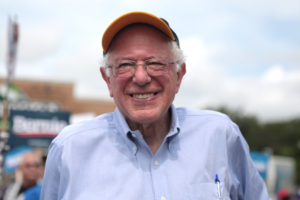Dakota Pipeline Struggle Between the ‘People’ and the ‘Powerful’ Remains Underreported
DAPL should be a seminal issue in the 2016 presidential election, as it relates to the larger issue of climate change, but all we hear from the mainstream media are crickets.
By Jerome Irwin

Angela Miracle Gladue, a member of the Frog Lake First Nations, a Cree community in Edmonton, Canada, attends a rally in support of the Standing Rock Sioux Tribe and in opposition to the Dakota Access oil pipeline. The event was in Lafayette Park near the White House in mid-September. (Jacquelyn Martin / AP)
A David and Goliath story is unfolding in North Dakota with a familiar theme: The “people” (who seek to do good for the planet) versus the “powerful” (who want to pursue evil that destroys the lives of the people and earth).
The colossal struggle around the extraction of the earth’s diminishing natural resources has been mounting since the Keystone XL pipeline proposal was commissioned in 2010. At that point, the Rosebud Sioux Nation in South Dakota and other native nations declared the pipeline construction “an act of war” that violates tribal sovereignty and abrogates treaty rights. The villainy continued when Bank of America became the lead financier of the lofty-sounding Plains All American Red River II pipeline that violated the same rights of the native peoples of Oklahoma.
This undeclared war continues in Canada with the controversial Kinder Morgan tar sands pipeline and export terminal facility. That proposal seeks to plow new pipelines and shipping lanes through the pristine wilds of Canada and its Salish Sea in order to transport some 890,000 barrels daily of Alberta tar sand liquid bitumen through areas inhabited by indigenous and non-indigenous peoples, as well as plants and animals.
Kinder Morgan, the largest pipeline company in the U.S., was founded by Richard Kinder, who took over from Jeffrey Skilling, the former CEO of Enron, now serving 24 years in prison for fraud and insider trading. Called “the luckiest ex-Enron employee” by The Wall Street Journal, Kinder is the 110th richest man alive, with a net worth of $8.2 billion. The real question is this: Because this proposal will increase Kinder’s wealth, will it, in the end, also make the lives of all the people and the earth’s natural-world denizens richer? Kinder Morgan’s proposal awaits the approval of Prime Minister Justin Trudeau and his liberal government.
Singer, songwriter and activist Neil Young—of Crosby, Stills, Nash & Young fame—wrote the song “Who’s Gonna Stand Up?” to protest the Keystone XL pipeline in 2014. Now he has composed another brilliant music video, “Mother Earth,” that speaks to Canada’s pipeline proposals and its repeated violations of First Nation peoples’ treaties and sovereign rights.
If or when the Canadian government gives the controversial Kinder Morgan pipeline the green light, as it recently did to the Petronas liquefied natural gas pipeline, another explosive confrontation with First Nation peoples, environmental groups and the citizenry will no doubt lead to the same kind of confrontational debacle currently unfolding in North Dakota, ever since the Army Corps of Engineers approved the construction of the Dakota Access pipeline (DAPL). If that proposal is approved by the new U.S. president and the current “voluntary pause” is lifted, the “black snake” will plow through 1,168 miles of Indian tribal lands, farming communities and endangered wildlife habitats, stretching from the Bakken oil fields in North Dakota to the Gulf of Mexico, and transporting up to 650,000-plus barrels of crude fracked oil per day.
On the “David” side of this struggle are the Standing Rock Sioux people. They oppose DAPL’s incursions into the sacred lands and waters of their homelands on the basis that the action violates their treaty rights as spelled out in the 1851 Treaty of Traverse des Sioux and 1868 Treaty of Fort Laramie.
Joining the Sioux are some 200 Native American tribes and nations in Canada and the United States, with additional support from throughout South America, Africa, Asia and Australia. While powerful corporate, union and labor leaders, such as AFL-CIO President Richard Trumka, endorse the Dakota Access pipeline on the supposition that it will stimulate employment and a healthier economy, a host of AFL-CIO minority workers—such as the Asian Pacific American Labor Alliance, Coalition of Black Trade Unionists, Coalition of Labor Union Women and Labor Council for Latin American Advancement—stand in solidarity with the Sioux. The coalition refers to the Sioux as “our Native American kinfolk, who are one of the most marginalized and disenfranchised groups in our nation.” The proposal is referred to as “A Pipeline of Corporate Greed”, and the coalition challenges the American labor movement to better engage native peoples and other marginalized people in the labor movement as a whole. One could characterize their collective resistance as an essential plank in the Our Revolution movement that began with Bernie Sanders’ run for the U.S. presidency.
On the “Goliath” side is Energy Transfer Partners, a huge, Texas-based, corporate conglomerate involved in the extraction of natural gas, gas liquids, crude oil and refined petroleum products from the earth. The company instead should be called “Energy Suckers Partners,” because its primary investors among Wall Street’s largest investment firms and financiers represent a vast array of banking institutions in Canada, the U.S., France, Great Britain, Scotland, Germany, Italy and Japan—and they are energy suckers who continue, in every conceivable way, to suck the natural resources and life force out of all the people and the earth.
This never-ending struggle between “the people” and “the powerful” rages unabated in every sector of the world, pitting tiny indigenous nations, workers unions, environmental groups, celebrities and alternative press against the world’s mightiest corporate-political-financial-mainstream media giants.
The list of environmental groups throughout North America that support the Standing Rock Sioux’s defense of their homelands is impressive: the Indigenous Environmental Network, Sierra Club, Greenpeace, Honor the Earth, Bold Alliance, 350.org, MN350, Rainforest Action Network, Center for Biological Diversity, Oil Change International, 350 Madison, Stand.earth, Family Farm Defenders, Save Our Illinois Land, Power Shift Network, Rising Tide North America, Minnesota Public Interest Research Group, Midwest Environmental Advocates, For Love of Water, Wild Earth Guardians, Friends of the Earth, International Forum on Globalization, U.S. Climate Plan, Iowa Citizens for Community Improvement, Earthworks, Water Keeper Alliance, Environmental America and the Science and Environmental Health Network.Alternative media coverage of this David and Goliath story has been led by the investigative reporting of “Democracy Now!”, which continues to report what the mainstream corporate press refuses to print or air. Despite a virtual mainstream news blackout, this story continues to seep into every corner of the earth and has sparked a mounting groundswell among various grass-root movements. Archaeologists and museum officials have denounced the destruction of the Standing Rock Sioux’s burial grounds by the Dakota Access pipeline. They have created a sign-on letter and encouraged archaeologists, anthropologists, historians and museum workers to add their names by emailing {encode=”[email protected]” title=”[email protected]”}.
Neil Young continues to show his support. Like his moving “Mother Earth” music video, he has created an equally emotional, thought-provoking, protest song called “Indian Givers.” The music video brilliantly summarizes, with news footage and lyrics, the issues behind the Standing Rock Sioux’s struggles. Young sings, “There’s a battle raging on sacred lands/ Our brothers and sisters have to take a stand/ Against us now for what we all been doing/ On the sacred land there’s a battle brewing … / I wish somebody would share the news/ Bring back the days when good was good … / Standing against the evil way.”
For perspective on how little coverage the mainstream press in North America has given to this conflict, Fairness and Accuracy in Reporting (FAIR), in a Sept. 22 report, found that in its search of the Nexis news database, Young’s song is “5 minutes, 39 seconds longer than the initial combined coverage of the controversy on the ABC and NBC networks.”
Despite this virtual mass media blackout, many celebrities have taken Young’s song to heart and are showing support for the Sioux peoples—including Leonardo DiCaprio, Mark Ruffalo, Shailene Woodley, Susan Sarandon, Riley Keough, Pharrell Williams, Rosario Dawson and the cast of “Justice League.”
Still, the lack of news reporting by major television and newspaper networks means that much of the story remains invisible to the general public. Similar to the ugly racial violence that occurred during the Civil Rights Movement in the 1960s, standing in solidarity with the Sioux is being punished. People who have traveled to North Dakota to protest the pipeline’s construction have ended up being pepper-sprayed, bitten and bloodied by vicious guard dogs and roughed up by hired security thugs. Amy Goodman from “Democracy Now!” broke the news story and was charged with criminal trespass for her courageous, on-site reporting. Yet few in the mainstream media, either then or since, have rushed to her defense. So much for protecting the freedom to report the truth.
Mainstream news networks also have failed to press each presidential candidate to explain where they stand on this conflict. Donald Trump has yet to directly comment on the Dakota Access pipeline project, though Harold Hamm, his energy adviser, and founder and CEO of Continental Resources, recently announced to his investors that he anticipates huge profits from fracked oil from North Dakota’s Bakken Shale Basin, destined to be transported to world markets by DAPL once the project is completed. Hamm, originally an outspoken supporter of the TransCanada’s Keystone XL pipeline, shifted his support to the DAPL once he realized the northern leg of the XL was doomed.
Another of Trump’s key advisers is North Dakota Gov. Jack Dalrymple. Like Trump, Dalrymple is a strong advocate of law and order—and he recently ordered armed National Guard troops to patrol key concrete-barrier checkpoints around the DAPL project to guard against possible outside agitators, and bolstered massively armed law enforcement security forces with MRAPs (Mine-Resistance Ambush Protected Vehicles), LRADs (Long Range Acoustic Devices), sound cannons, guard dogs, pepper spray, tear gas and shotguns. This overkill response is arrayed against Sioux men, women, children—water protectors and their supporters—armed only with their prayers in peaceful protest.
Democratic presidential nominee Hillary Clinton, whose campaign has taken more money from Wall Street’s oil and gas barons than Trump’s, also has refused, to date, to voice any opinion about DAPL, the outrageous treatment of the Standing Rock Sioux and the brazen violations of their treaty rights. Her silence contrasts with the lip service her party’s platform has paid to support native people’s tribal sovereignty, resources and sacred sites.
Gary Johnson, the Libertarian presidential nominee, has issued an insipid statement calling upon state and tribal leaders to work together to reach an agreement that respects both the rights of private businesses and landowners and the treaty rights of native peoples. At the same time, Johnson accuses outside forces of latching on to the issue to further their own agendas.
On the other hand, Jill Stein, the Green Party’s presidential candidate, and her running mate, Ajamu Baraka, are the only candidates to put their bodies on the line by protesting with the Sioux. As a result, Stein and Baraka, like Goodman, have been charged with a crime, and warrants have been issued for their arrest for trespassing and committing mischievous vandalism when Stein dared to spray on a DAPL Caterpillar bulldozer blade the words “I approve this message.” Baraka sprayed the word “decolonization.”
DAPL should be a seminal issue in the 2016 presidential election, as it relates to the larger issue of climate change, but all we hear from the mainstream media are crickets.
FAIR Editor Jim Naureckas lamented the plight of the Standing Rock Sioux people by pointing out a refrain in Young’s “Indian Givers”: “I wish somebody would share the news.”
“I wish more corporate media decision-makers were Neil Young fans,” Naureckas said.
That would help raise public awareness of this important battle.
Jerome Irwin regularly appears in the alternative press in the United States, Canada and Australia. During the 1960s and early ’70s, he lived with the Dakota and Lakota peoples on the Crow Creek Sioux and Oglala Sioux reservations in South Dakota. He later published “The Wild Gentle Ones: A Turtle Island Odyssey,” a book that documents these tribes’ historical plight and that of other indigenous peoples on Turtle Island.
Your support matters…Independent journalism is under threat and overshadowed by heavily funded mainstream media.
You can help level the playing field. Become a member.
Your tax-deductible contribution keeps us digging beneath the headlines to give you thought-provoking, investigative reporting and analysis that unearths what's really happening- without compromise.
Give today to support our courageous, independent journalists.






You need to be a supporter to comment.
There are currently no responses to this article.
Be the first to respond.